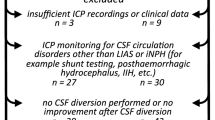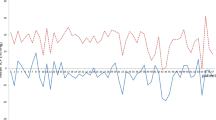Abstract
Background
One important goal of modern treatment of pediatric hydrocephalus is to normalize the intracranial pressure (ICP) and ICP volume reserve capacity to optimize normal brain development. Better knowledge of the characteristics of ICP waves/ICP in pediatric hydrocephalus may provide new insight into the mechanisms behind modern hydrocephalus treatment. The aim of the present work was to characterize the ICP waves/ICP in children with either communicating or non-communicating hydrocephalus who improved clinically after surgery. The hydrocephalic children not treated surgically following ICP monitoring served as reference patients.
Methods
The patient material includes all children with hydrocephalus and no previous surgical treatment who underwent diagnostic ICP wave/ICP monitoring during the period 2002–2011. We retrieved the information about the patients from the patient records and the digitally stored ICP waveforms. The ICP wave characteristics amplitude, rise time and rise time coefficient and the mean ICP were determined in the patients treated surgically for their hydrocephalus. The findings were compared with findings in children not treated surgically after ICP monitoring who served as reference patients.
Results
The patient material includes 58 patients. Thirty-one (53 %) were treated surgically after ICP monitoring, of whom all improved clinically. As compared to the reference patients, patients treated surgically presented with increased ICP wave amplitudes (MWA) and mean ICP. Alterations were comparable in communicating and non-communicating hydrocephalus. We found no apparent association between the ICP wave/ICP scores and presence of symptoms, indices of ventricular size or age.
Conclusions
Children with either communicating or non-communicating hydrocephalus improving clinically after surgery presented with elevated MWA and mean ICP. In particular, the levels of MWA were raised to a magnitude seen when intracranial compliance is impaired. Hence, the present observations may support the idea that improvement of intracranial compliance can be an important mechanism by which shunts work in pediatric hydrocephalus.





Similar content being viewed by others
References
Alperin NJ, Lee SH, Loth F, Raksin PB, Lichtor T (2000) MR-Intracranial pressure (ICP): a method to measure intracranial elastance and pressure noninvasively by means of MR imaging: baboon and human study. Radiology 217:877–885
Arriada N, Sotelo J (2002) Review: treatment of hydrocephalus in adults. Surg Neurol 58:377–384, discussion 384
Avezaat CJ, van Eijndhoven JH, Wyper DJ (1980) Effects of hypercapnia and arterial hypotension and hypertension on cerebrospinal fluid pulse pressure and intracranial volume-pressure relationships. J Neurol Neurosurg Psychiatry 43:222–234
Bekar A, Dogan S, Abas F, Caner B, Korfali G, Kocaeli H, Yilmazlar S, Korfali E (2009) Risk factors and complications of intracranial pressure monitoring with a fiberoptic device. J Clin Neurosci: Off J Neurosurg Soc Australas 16:236–240
Czosnyka M, Czosnyka ZH, Whitfield PC, Donovan T, Pickard JD (2001) Age dependence of cerebrospinal pressure-volume compensation in patients with hydrocephalus. J Neurosurg 94:482–486
Drake JM (2008) The surgical management of pediatric hydrocephalus. Neurosurgery 62(Suppl 2):633–640, discussion 640–632
Eide PK (2003) The relationship between intracranial pressure and size of cerebral ventricles assessed by computed tomography. Acta Neurochir (Wien) 145:171–179, discussion 179
Eide PK (2006) A new method for processing of continuous intracranial pressure signals. Med Eng Phys 28:579–587
Eide PK, Bentsen G, Sorteberg AG, Marthinsen PB, Stubhaug A, Sorteberg W (2011) A randomized and blinded single-center trial comparing the effect of intracranial pressure and intracranial pressure wave amplitude-guided intensive care management on early clinical state and 12-month outcome in patients with aneurysmal subarachnoid hemorrhage. Neurosurgery 69:1105–1115
Eide PK, Egge A, Due-Tonnessen BJ, Helseth E (2007) Is intracranial pressure waveform analysis useful in the management of pediatric neurosurgical patients? Pediatr Neurosurg 43:472–481
Eide PK, Kerty E (2011) Static and pulsatile intracranial pressure in idiopathic intracranial hypertension. Clin Neurol Neurosurg 113:123–128
Eide PK, Sorteberg W (2007) Association among intracranial compliance, intracranial pulse pressure amplitude and intracranial pressure in patients with intracranial bleeds. Neurol Res 29:798–802
Eide PK, Sorteberg W (2010) Diagnostic intracranial pressure monitoring and surgical management in idiopathic normal pressure hydrocephalus: a 6-year review of 214 patients. Neurosurgery 66:80–91
Eide PK, Stanisic M (2010) Cerebral microdialysis and intracranial pressure monitoring in patients with idiopathic normal-pressure hydrocephalus: association with clinical response to extended lumbar drainage and shunt surgery. J Neurosurg 112:414–424
Fouyas IP, Casey AT, Thompson D, Harkness WF, Hayward RD (1996) Use of intracranial pressure monitoring in the management of childhood hydrocephalus and shunt-related problems. Neurosurgery 38:726–731, discussion 731–722
Gelabert-Gonzalez M, Ginesta-Galan V, Sernamito-Garcia R, Allut AG, Bandin-Dieguez J, Rumbo RM (2006) The Camino intracranial pressure device in clinical practice. Assessment in a 1000 cases. Acta Neurochir (Wien) 148:435–441
Gonzalez-Darder JM, Barcia-Salorio JL (1989) Pulse amplitude and volume-pressure relationships in experimental hydrocephalus. Acta Neurochir (Wien) 97:166–170
Greitz D (2004) Radiological assessment of hydrocephalus: new theories and implications for therapy. Neurosurg Rev 27:145–165, discussion 166–147
Hommelstad J, Madso A, Eide PK (2013) Significant reduction of shunt infection rate in children below 1 year of age after implementation of a perioperative protocol. Acta Neurochir (Wien) 155:523–531
Koskinen LO, Grayson D, Olivecrona M (2013) The complications and the position of the Codman MicroSensor ICP device: an analysis of 549 patients and 650 Sensors. Acta Neurochir (Wien) 155:2141–2148, discussion 2148
Lofgren J, von Essen C, Zwetnow NN (1973) The pressure-volume curve of the cerebrospinal fluid space in dogs. Acta Neurol Scand 49:557–574
Lutz BR, Venkataraman P, Browd SR (2013) New and improved ways to treat hydrocephalus: Pursuit of a smart shunt. Surg Neurol Int 4:S38–S50
McCullough DC (1980) A critical evaluation of continuous intracranial pressure monitoring in pediatric hydrocephalus. Childs Brain 6:225–241
Miller JD, Garibi J, Pickard JD (1973) A clinical study of intracranial volume pressure relationships. Br J Surg 60:316
Misaki K, Uchiyama N, Hayashi Y, Hamada J (2010) Intracerebral hemorrhage secondary to ventriculoperitoneal shunt insertion–four case reports. Neurol Med Chir (Tokyo) 50:76–79
Schuhmann MU, Sood S, McAllister JP, Jaeger M, Ham SD, Czosnyka Z, Czosnyka M (2008) Value of overnight monitoring of intracranial pressure in hydrocephalic children. Pediatr Neurosurg 44:269–279
Stagno V, Navarrete EA, Mirone G, Esposito F (2013) Management of hydrocephalus around the world. World Neurosurg 79(S23):e17–e20
Steinbok P, Milner R, Agrawal D, Farace E, Leung GK, Ng I, Tomita T, Wang E, Wang N, Wong GK, Zhou LF (2010) A multicenter multinational registry for assessing ventriculoperitoneal shunt infections for hydrocephalus. Neurosurgery 67:1303–1310
van Eijndhoven JHM AC (1983) The CSF pulse pressure as indicator of intracranial elastance: The role of the pulsatile change in cerebral blood volume. In: S Ishii NN, M Brock (ed) Intracranial pressure V. vol V. Spronger Verlag Berlin-Heidelberg, pp 191–196
Wahlin A, Ambarki K, Birgander R, Alperin N, Malm J, Eklund A (2010) Assessment of craniospinal pressure-volume indices. AJNR Am J Neuroradiol 31:1645–1650
Conflicts of interest
Terje Sæhle, MD, discloses no conflicts of interest. Per Kristian Eide, MD, PhD, has a financial interest in the software company (dPCom AS, Oslo) manufacturing the software (Sensometrics Software) used for analysis of the ICP recordings.
Author information
Authors and Affiliations
Corresponding author
Rights and permissions
About this article
Cite this article
Sæhle, T., Eide, P.K. Characteristics of intracranial pressure (ICP) waves and ICP in children with treatment-responsive hydrocephalus. Acta Neurochir 157, 1003–1014 (2015). https://doi.org/10.1007/s00701-015-2410-z
Received:
Accepted:
Published:
Issue Date:
DOI: https://doi.org/10.1007/s00701-015-2410-z




